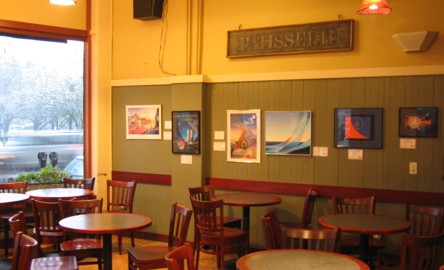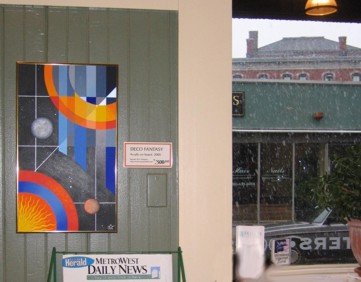My weblog ELECTRON BLUE, which concentrated on science and mathematics, ran from 2004-2008. It is no longer being updated. My current blog, which is more art-related, is here.
Sun, 30 Oct, 2005
Art Day with Snow
Natick, Massachusetts, twenty miles west of Boston, is a town which could have been designed by Norman Rockwell. There is a bandstand gazebo on the village green, historic red-brick buildings around it, and old-fashioned shops and cafe's. An old industrial town is being transformed into an arts town, and the Center for Arts in Natick is doing great work in many locations, including the "Bakery on the Common" coffee-house art gallery. This is where my art show, which I have worked on all summer and fall, is now on display.
It has been chilly and moist all week, and on October 29, the day of the opening, the weather was
unusual even for New England. Cold grey clouds in the morning dropped snow all
afternoon, leaving an inch or so of white on the golden autumn leaves, and the bandstand on the
green.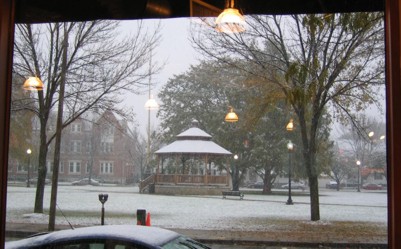
But inside the Bakery on the Common it was warm, inviting, and caffeinated.
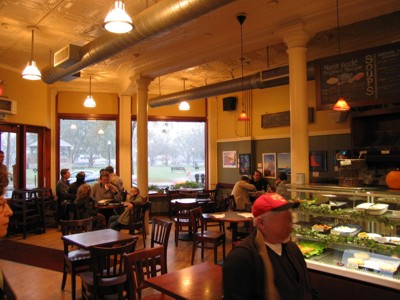
My mother and two of my best Massachusetts-area friends joined me to help put up the show, and as the afternoon progressed, despite the snow, more relatives and friends showed up to wish me well and look at the art. Pictures that I have shown on this Weblog are now up on the walls. Here is the display on the back wall near the window.
And here is my "Deco Fantasy," on a panel on the other side of the gallery, next to a window and a newspaper rack. Note the snowflakes falling outside the window.
I am much relieved that this is finally happening. If someone buys a picture, I'll be thrilled. Now you are all invited to come to the Bakery, sip a coffee, and look at my art. I have to go back to my own home in a couple of days, so I can't introduce my art in person, but if you're near Natick, Massachusetts, come on by. It will be up till the end of December.
Posted at 2:24 am | link
Wed, 26 Oct, 2005
Massachusetts again
I've been doing this run now for more than seventeen years, and rarely have I done it in worse weather. I traveled the first section under ominous skies, watching hurricane-like clouds move in. It was not far from the real thing. As I huddled over my computer in my hotel room (thank you for that wireless access…I love Hampton Inns!) high winds whipped heavy rain past the urban landscape. As I set off on the second section of my journey, the rain was still falling. I saw flooded streets and downed trees, with soaked autumn leaves strewn everywhere. I visited a friend whose apartment entrance was blocked with a big fallen tree. After dinner, I set off on the last section northward to Massachusetts, in Stygian darkness, fog, and bitter cold mist. It brings back fond memories (not) of my original home state.
On those dark wet roads I thought of physics, how the simple physics I am studying goes with road trips. The water diminishes the coefficient of friction between the Electron's tires and the road, so I must struggle harder against wind and rain to keep the car on course. Banked turns add a third dimension to curved motion, while vehicles of all sizes and speeds have their appropriate momentum which I have to avoid.. Thinking about physics helps me stay awake on the long drives. Can an Electron have friction? It's a long particle path from my studio home to Massachusetts.
But now I'm here along with the packed art; this part of my mission is done. The next stage will be on the weekend when the art is put up in the gallery. For now, I'm back in the folks' house, in the dim reddish light, with the globalized, fragmented mishmosh of the perpetual television talking of one catastrophe after another: dying salmon, environmental degradation, war, poverty, plague, floods, SUV ads. The black-green woods loom outside the window. I have my physics book with me, hoping to have at least some moments in the world of calculation and exactitude.
Posted at 3:59 am | link
Tue, 25 Oct, 2005
Northbound
October is the month the darkness starts, which will not lift in this part of the world until April or even May. As I drove north towards Massachusetts, the sky filled with rushing, ragged grey clouds, moving over a higher background of turbulent overcast, as if one of this year's awful hurricanes were coming to the Northeast rather than destroying the South. If I ever had any idea of moving to a part of the USA with no winter, this year has changed my mind. Those places either don't exist any more or have too many hurricanes. By the time I got to my halfway stop point (it takes me two days to drive to Massachusetts from my home) the rain was starting. By dinner-time, wind-driven rain splashed over the parking lots, the bright highway signs, the browning landscape.
I am going north to my old home town to set up my art show. I've worked on this all summer, and you've seen some of the paintings I'm going to display. If all goes well, the opening is on October 29. As soon as the show is up, I will give the location on this Blog, so that Electron readers in Massachusetts can go see it.
In another reality, I am going to a physics conference, not an art show, where I will present a paper. Instead of sipping coffee and munching muffins at a coffeehouse gallery, I (or, as I will explain, another I), will be drinking with the other physicists at the bar of some slick, but rustic resort, where in front of a big wood fire in a stone fireplace, we will discuss our work on dark matter and string theory and the prospects of the big new colliders. In this other reality you would not know me. I would have what is known in the "virtual world" as an "avatar," a realistic electronic persona created to represent me in a virtual environment. My "avatar" would know a great deal more physics than I do. He (yes, he) would be able to hold conversations on everything from quantum computing to the symphonies of Gustav Mahler. And he would be able to go on those rugged hikes in the foothills where physicists talk more physics and breathe fresh air. You'd never know that this was an avatar rather than a "real person," except that lately, he sometimes inexplicably dreams that he is about to put up an art show in a medium-sized town west of Boston.
Posted at 2:29 am | link
Fri, 21 Oct, 2005
Laundry Information
I'm finally recovering from the two-week cold, and I have more energy now. But even during the depths of my affliction, I managed to do some things. I read a book about information theory and physics called INFORMATION: The new language of science by Hans Christian von Baeyer, a physics professor at the College of William and Mary in Virginia. And I did laundry.
In his short and very well-written book, Baeyer introduces science-minded readers like me to the field of "information theory." This was first proposed by Claude Shannon (1916-2001), a mathematical engineer who laid the mathematical groundwork for modern computing and telecommunications, including the Internet itself. Baeyer follows the inspiration of another great physicist, John Wheeler, who dared to ask why the quantum world, the very basis of reality, was divided up into "granules" rather than flowing in a continuous stream.
I can't say that I understood everything in this book, but I met up with the idea of "information content" and "information strings" as Baeyer explained Shannon's ideas. This is where the laundry comes in. My laundry could be considered as a vehicle of some very simple information, which can be lost through "information entropy," and regained through the addition of energy, namely, mine.
I am no fashion plate. I wear the same thing all the time, in a limited number of colors. I wear faded black jeans and a T-shirt, in the winter, a turtleneck shirt. My wardrobe is saved from complete dullness by the colors I wear. I wear black, orange, and light blue shirts. I have a stack of T-shirts in these colors. I wear them one by one, day by day, and then throw them in the laundry pile. The sequence of T-shirts as I wear them through a period of, let's say, nine days, provides a simple, and truly meaningless, information content: black, blue, blue, orange, black, orange, black, blue, black. These nine shirts could be considered a nine-part information string, built from only three character options.
But when I take the shirts off, and throw them in the laundry pile, their pattern sequence is destroyed. Laundry information has entropized in the pile. There is no remaining record, since I'm not that insane, of what shirts I wore in what order. When the pile is then placed in the laundry machines and washed and spun, the information is completely scrambled and ceases to exist. And then I dump the clean laundry in a pile, where it continues to have no information content, or at least nothing resembling what it had before.
Here is where energy must enter the system. Nothing gains order without external energy being applied to it. This energy is me, folding the laundry, a task I heartily dislike. And what do I do? I sort the T-shirts by color. All the black ones in a stack, all the blue ones, all the orange ones together. Then I stash them on the storage shelf. They are now in order, and ready to provide another meaningless string of information, depending on which ones I pick for which days. This may not be high-level information physics, but I can now see how a system can be scrubbed clean of its previous information before being re-used, and how much energy it takes to do it. What it means to me is that I really wish someone else would do my laundry.
Posted at 3:19 am | link
Wed, 19 Oct, 2005
Cough and spin
I'm slowly recovering from my cold, which has brought me two weeks of hacking and coughing, congestion, weakness, and confusion. Some of my friends and co-workers also had it, and the progression is exactly the same for everyone who gets it. Thankfully, it is not the dreaded and still hypothetical bird flu, which I and thousands of others in Europe have panicked over in the last week. There have been just too many catastrophes this year, and we are all on edge.
I am back at work; due to the spacing of weekends, I only missed one day at work due to the cold. But I have been working at home to get my show in Massachusetts ready. When it is done I will give out the date of its opening, and a Web reference to it. I decided to drop the painting I was working on, which wasn't turning out so well, and substitute another really good one which I had from earlier in the year, my 9/11 tribute called "The Geometry of Remembrance."
I will have seven original paintings in the show and two prints, CITY OF DREAMS and CITY OF LIGHT, which you have probably seen in my "Art Gallery" on the main Pyracantha site. Much of this work could also go into a science fiction convention art show, and I intend to show it at my next convention. In fact, I think this show is worthy of a Worldcon, but I won't be going to a Worldcon for quite a while to come.
I regret to say that during the worst of my coughing and sputtering and panicking, I was not able to do any physics. I was too weak, confused, and distracted. But I have gone back to my book, and from sliding blocks I have now gone to spinning weights, which I have encountered before. The rest of the chapter is devoted to more Newtonian basics, so I will be revisiting the world of rotation and gravity.
Posted at 2:47 am | link
Sun, 16 Oct, 2005
Sliding blocks
I have had a miserable cold for more than a week now. I cough and hack like a dog, and I have no energy. I have missed at least one day of work. There is no special treatment for it other than the usual: drinking liquids, taking over-the-counter cold and cough medicines, and rest. I am helping to keep Poland Spring of Maine in business, drinking their excellent sparkling water. A friend has brought over her delicious and comforting chicken soup. If all else fails, Glenfiddich single-malt scotch is my friend.
The forced interruption of my hard-working routine is very upsetting. I need to finish art for the show and get my stuff ready to travel. Stuck in my rooms instead of out doing errands, I get the weird feeling that I am alone in the city, with hardly any sound from the usually noisy neighbors in the other apartments. I watch TV, which I rarely do. I check wistfully for e-mails, and surf the web, hoping for some news which is not about disasters, but there isn't any. I read about the upcoming plague of deadly bird flu, which will make my current cold look trivial. Hurricanes, earthquakes, floods, and now plague. Late at night, I panic. Why bother to plan for the future? If the plague is gonna get us, why not spend all our money on mindless pleasures now and forget about improving the world?
Something about this little virus makes me depressed as well as sick. I am told that its progress is exactly the same with other people who get it; it lasts from 10 to 14 days, and recedes only to come back again if you get active too soon. Today, I was able to drag myself outside (after two days of confinement) and do some important errands, and tonight I resumed painting. I needed to finish the airbrush background of my latest picture, and get the airbrush and its accessories off the floor and the worktable so I can use the space. This is now done, so I can finally reclaim a few feet of studio space.
But there is always physics. Even at my sickest, I coughed my way through my return to Newton's f = ma. I might only be able to do one or two problems a day, but I did them. Physicists, my current heroes, will work on physics no matter what shape they're in: sick, hung over, awake thirty-six hours in a row, no matter where they are. I can do the same thing, except I'm working on block-headed problems about blocks, rather than string theory or quantum gravity.
Schaum's, the superior physics text, has a lot of material about sliding blocks. Some of them are tied together with ropes or cords, some of them pull on each other, through a pulley, on two sides of an incline. Some of them glide on those frictionless surfaces that exist only in physics textbooks, while others have to be pushed along against a co-efficient of friction. They get piled and packed together, tied up in trains, hung, and dropped. The book presents a situation, complete with diagram. I have not encountered it before, so I try to figure out, with the physics I know, how it might be analyzed. Since I don't really know, I then have recourse to the explanatory text and solution that follows directly after the question. Since I have no teacher in front of me to demonstrate it on the blackboard and tell me about it (or sarcastically tell me how wrong I am), I imagine that the book is talking to me, and I take notes. Sooner or later I will get familiar with the ways sliding blocks and hanging weights are handled in the abstract language of physics. No matter what else is happening, there is always one place where things work.
Posted at 3:33 am | link
Mon, 10 Oct, 2005
Seasonal Art
Despite dragging with a cold, I managed to finish another painting this weekend. This is for my upcoming show in Massachusetts. The gallery director suggested that I do some pictures with seasonal themes, as that would be attractive to visitors, especially in New England during the colorful fall. So here is the one I came up with for Autumn. It's a homage to those clever surrealists who play with image puns and transformation, such as Rob Gonsalves. Gonsalves' art is full of neat ideas, including ones with autumn leaves, so I figure, I can do it too, using my background of space art. So in this picture, the autumn leaves which the New Englanders will be raking up at the time of this show, turn into a galaxy in the whirls of the November wind.

In other news, my flowering cactus has been identified. It is a Discocactus zehntnerii, native to Brazil. This plant always blooms at night. As I expected, the cactus experts online immediately knew what it was, and once I knew the Latin name, I looked it up in my encyclopedia of cacti and there it was. I like the name "Discocactus," it conjures up visions of a cactus dancing all night to a repetitive late '70s pop beat while sticking its flowers up in the air. Or perhaps its globular shape is suspended from the ceiling as it reflects glitter light onto the hot dance floor. Boogie down, Bucky.
Posted at 2:15 am | link
Sun, 09 Oct, 2005
The Little Factory
I've been solving problems in "simple machine" physics. I don't solve them without the book's help, usually. I often lose track of the problem and miss noticing important data or forms of data, which then gives me the wrong answer. Other times, I try to review the formula given in the book but find it inconsistent. Sometimes, for instance, it's a ratio of load to effort that gives you the number you need, and other times, it's effort to load. Or I have to remember to calculate not the mass, but the weight of an object before I can proceed with finding out how much force it takes to push it up an inclined plane. I will probably forget most of this, but when I encounter it again, it will be familiar to me.
I have cranked imaginary cranks, tightened virtual vises, pushed loads up fantasy hills, pulled pulleys and levered levers. I have even lifted non-existent loads with a theoretical hydraulic jack. I had no need for my aforementioned heavy boots to do this work, just my old pencil and a pad of paper. I continue to live in an industrial environment which demands no physical effort, in which there is no risk of anything falling on me. "A torque of 50 Newton/meters is applied to a gear with 30 teeth," I am informed. The gear and its system does not exist, at least not this particular system. Or perhaps it exists in a kind of miniature virtual world of the imagination. Some cosmologists, calculating theories almost infinitely more complex than my gears and levers, invoke what they call "toy universes" to help them out, where all the complicating factors have been reduced to only a few variables so that their theory will calculate cleanly. Perhaps that's where I am, in a little factory where work goes on in its full complexity, though as a giant I see only the basic, simple mechanics I am tasked to learn.
I have a friend named Michael (one of many Michaels I know) who grew up in an industrial town in northern Ohio, though he now lives in the suburbs of Philadelphia. He is a metallurgical engineer who is also a theater set designer and builder. He is an expert in historical metal industry in America, especially steelmaking such as used to go on in his home town. Using both his industrial knowledge and his set design skills, he has built a tiny model of his old home town in his basement, complete with moving HO-scale trains, and everything from farmland to city blocks to stores and gas stations. The masterpiece of his miniature city, though, is a model of a steel mill and its surrounding buildings, along with an ore boat and the raw materials piled up in heaps. If you peer closely at this wonderful creation, you can see simulated glowing ingots on rail carts, open hearth furnaces, rolling mills, and administration offices. He even applied simulated grit and dust to the surfaces, to make it look realistic. And it is populated by tiny workers, no more than an inch high, directing trains or moving heavy objects, using all those machines which I have been levering and pushing and pulling with numbers. The cities have little people and cars (all dated to the early 50s, as this is a period piece based on nostalgic memories of a time of industrial prosperity). There is even a thumbnail-size farmwife standing on the porch of a farmhouse no bigger than a box of cookies, with cornstalks the size of matchsticks.
I call this miniature city "MichaelCosm," though Michael has never given it a name. When I visit Michael and his wife Pat, they know that the first thing I need to see in their house is the world in the basement. Michael leads me down into the blackness, and then turns the light on. He throws the switch for the trains to run, and MichaelCosm comes to life.
"You know," I say to him, "this place goes on living when you're not here. The people have their own lives, their own stories, their own work and play and sadness and joy. They have no idea that they are miniature creations. Perhaps they think you're God."
Michael doesn't answer. He's an engineer, and engineers don't think in that fanciful way. He just wants to make the trains run on time and keep the steel moving. Or at least that's what he says.
I always tell him that I wished that his steel mill could light up with fiery light and puff steam, just like real ones. Michael says that other miniature builders have simulated this with fiber-optics and artfully placed lighting, but it is very expensive and time-consuming, and he can't afford it right now.
"But could a factory this tiny actually produce steel?" I ask. "Could cupfuls of coke and ore be cooked in blast furnaces, and pour peanut-size ingots to be turned into inch-wide girders and walnut-sized car bodies?"
"No," he replies, "the scale is too small. It couldn't work. We just have to imagine it."
And so that's where I stand now, calculating simple work as an engineer in my little factory, thinking of those inch-high workers in their hardhats, toiling diligently so that I can learn my physics.
Posted at 3:32 am | link
Thu, 06 Oct, 2005
On being a Variable Infrared Source
I am a female of a Certain Age, and that means that I am undergoing the "change of life," or menopause. Just the mention of the word "menopause" causes some people to giggle, and others to tune out in disgust. Menopause is dorky, totally un-cool, undignified. Our glitzy, fabulous Western culture of the early twenty-first century is especially embarrassed by the physical signs of aging. There are pills for that, you know. Plastic surgery is available for all that icky aging skin, the pudgy midriff, the puffy, sagging jowls. Fake boobs for flatness or droop. Botox for the face wrinkles, and collagen to plump up the pursed, disapproving lips. Perhaps someday, it will be made mandatory, as in that famous Twilight Zone episode where all women are forced to undergo plastic surgery to be beautiful. (Episode: "Number Twelve Looks Just Like You" from 1964)
Even physicists are now marketed as gorgeous babes or hunks, not only young and attractive but athletically fit, running marathons and climbing mountains and skiing in between their calculations. Physics is a young man's (and now, sometimes, a young woman's) game, played by athletes of mind and body—or at least that's how they present themselves on their Weblogs! Have they succeeded in convincing us readers that physicists don't have to be nerds? What about the widely believed notion that physicists and mathematicians do their best work before the age of thirty, like athletes, and then decline into dullness for the rest of their lives? Are physics and age compatible?
I know a hot flash is coming a minute or so before it actually arrives. I feel a kind of spasm in my guts, almost like the twanging of a bowstring. It gives me warning that I should stop what I'm doing and sit down somewhere, or brace myself somehow. As the flare approaches, I sometimes feel a wave of nausea, more often a feeling as if I am about to suffocate on hot air. Then the heat reaches my surface, rather like an aging star emitting bursts of sickly radiation, and I sweat for about three to five minutes. More like steam than sweat; I actually warm and moisten the air around me, and I can feel it rising like hot water vapor. Then the flash subsides, leaving me sticky and finally cooled, if not chilled. And this happens every thirty minutes or so.
Hormone replacement, according to the doctors, is not advised; it's dangerous. I have been taking soy extract, with varying results; sometimes it works too well and gives me other problems, other times, such as now, it isn't working at all. I've taken various herbal nostrums, which only served to make me cranky and jittery (they contain caffeine-like substances, which add too much to my usual espresso). I can only hope that the hot flashes will be counteracted by the colder weather of fall and winter, which is as it were, "cold comfort" since I love the hot weather of summer. It will be a while before these subside for good; in fact, my doctor has told me that some women never stop having them.
So what does this have to do with physics? Why would I try to play a young person's game when I am obviously physically and mentally too old? My friends gave me a set of napkins with a cartoon on them of a nun in full habit frantically fanning herself, titled "Sister Mary Menopause." Are there physicist ladies out there fanning themselves with pages of scribbled calculations while poring over the latest data from the particle detector? Perhaps it's just too horrifying to imagine.
I decided to turn the situation around. I will use the infrared flares as an opportunity to do more physics. I have installed a good old air-blowing fan in my cluttered studio. I call it the "science fiction fan." When I get that 60-second warning, I turn from the art that I'm doing and set the fan to "high." Under the cooling stream of air, I do a physics problem from my current chapter. It takes just about one hot flash to do a short physics problem, for instance in my current "simple machines" section. If I don't finish before it stops, then I turn down the fan and go back to it next time around. I can do this indefinitely. That doesn't mean that I need the hot flash to do physics, and I will gladly plug away at it under any circumstances. But instead of just sitting and stewing, I will make the association between my physical annoyance and my physics challenge. No matter how low the mechanical efficiency gets, I will still do the work.
Posted at 3:08 am | link
Sun, 02 Oct, 2005
Cactus Extravaganza
On October 1 and 2, Bucky the cactus bloomed again. Not only did it (he?) produce a second round of flowers, it had four at once. It must have been a great summer for cacti here on my terrace. Bucky had the good timing to bloom not only on a perfect sunny early fall day, but on a day when I was not at work and could observe and document the whole process. I find the speed of this blooming amazing. The buds emerge, open, and close within 24 hours. Night-blooming cacti are pollinated by moths, night-birds, and even bats. It's a very specialized ecological strategy.
I have tried to find out the species of this cactus and am getting close to a clear identification. I believe that it is a member of the Echinopsis family, since my cactus books tell me that this type of cactus blooms at night while other similar ones bloom by day. There is a surprisingly large amount of cactus material available on the all-knowing Web. I found sites maintained by people who are wildly devoted to their spiny friends, such as this one. There is an "Identify Your Cactus" forum where experts will be able to tell me just what kind of cactus Bucky is.
So here is the photo-sequence I have put together (my apologies to those who have slower connections) so that you can see Bucky's latest flower moment.
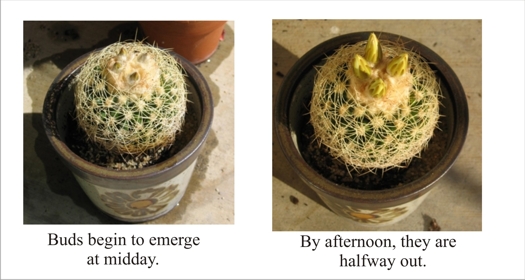
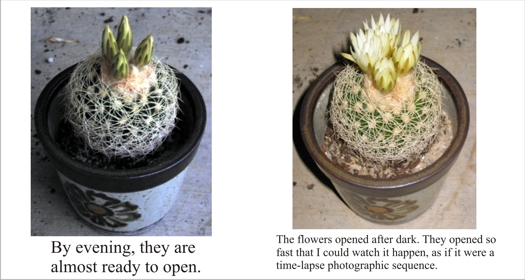

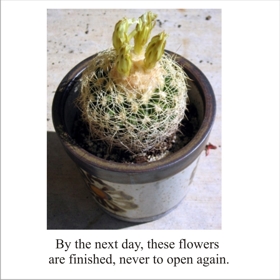
Posted at 11:46 pm | link

